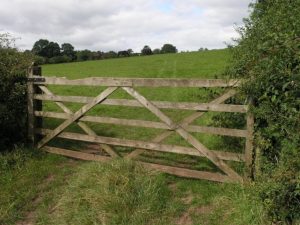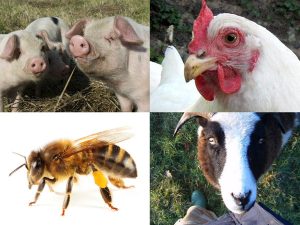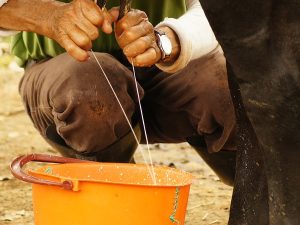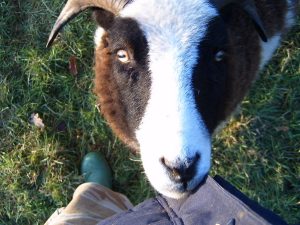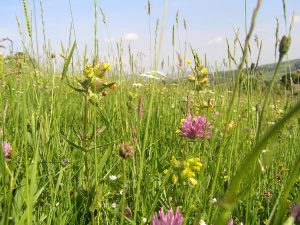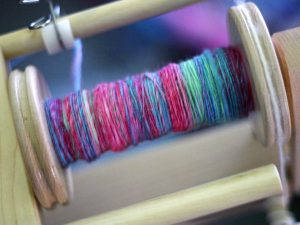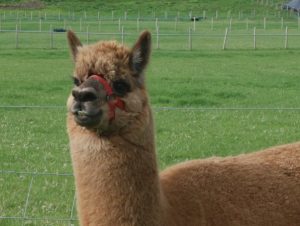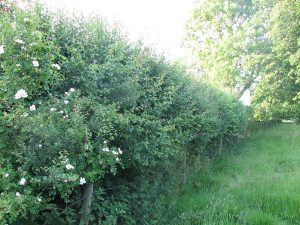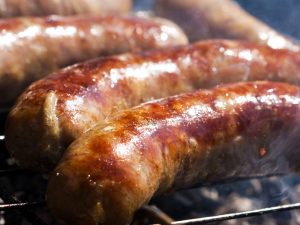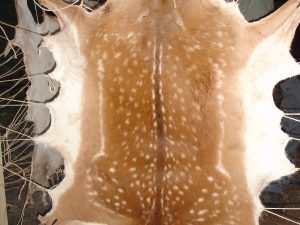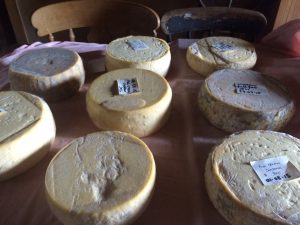Goats - introduction

“Goats are the cable talk show panelists of the animal world, ready at a moment’s notice to interject, interrupt, and opine. They have something to say about everything, little of it complimentary. They are the most impertinent animals I have ever known.” – Jon Katz
Contents
What are goats?
The domestic goat (Capra aegagrus hircus) is a subspecies of the wild goat, or Bezoar Ibex, of south-west Asia and eastern Europe, and was domesticated 10,000 years ago. A ruminant mammal, goats are closely related to sheep but differ significantly in their characteristics and quirks.
Goats have evolved to be browsers, foraging a wide variety of fibrous woody material from shrubs and trees, and are liable to chew on anything remotely woody. This has given rise to a reputation for indiscriminately eating everything in sight, including your pants off the washing line. In fact, they can be extremely fussy about their food, rejecting anything from a bucket that is not perfectly clean.

Good fences are essential! Goats are intelligent and curious; this, combined with an aptitude for climbing, makes them notorious escape artists and cunning thieves of the feed room. A reputation for stubbornness has probably arisen from their tendency to turn to face a threat rather than fleeing as a group. This makes it easy to get into a standoff with a goat, and means they are not as easily herded as sheep.
Possibly the most versatile agricultural animal, goats around the world produce milk, meat, yarn, leather, and dung; carry packs; work in harness; and clear overgrown land. In the UK, the main breeds are: the Angora and Cashmere goats for fibre production, Boer goats for meat production, and Saanen, Toggenburgh, Golden Guernsey, Alpine and Anglo Nubian for milk.
What are the benefits of keeping goats?
Personal
Goats are well suited to smallholdings. They’re accessible and affordable for those wanting to produce their own meat, dairy or fibre. The expanding market for goat products means that farm surplus can often be sold with ease. They can produce well on land considered to be marginal and can be an effective tool for the control of weeds – choosing to eat nettles, top thistles and eradicate bramble patches and Japanese knotweed. This preference for browsing over grazing means they’re suitable for those interested in multi-species grazing as they efficiently convert sub-quality grazing matter that is less desirable for other livestock into nutritious food.
Goat meat contains low amounts of saturated fatty acids and is considered to be a healthier alternative to other types of red meat. Unprocessed goat milk, which is commonly made into cheese, ice cream, yogurt and kefir, also has a reputation for being healthier, which could be due to the fact that goat milk has smaller, well-emulsified fat globules that make it easier to digest. Goat milk also responds well to simple cheesemaking methods and aspiring cheesemakers can often achieve success with chevre recipes.

Environmental
Producing meat ourselves in communities reduces the length of supply chains, and you have control over the way it’s produced – i.e. no nasty chemicals.
Democracy
Providing things for ourselves in communities rather than buying them from corporations helps prevent extraction, decentralises power and therefore prevents the corruption of democracy.
Community
In case of any kind of collapse scenario (broken supply chains, environmental destruction, financial crash, war, civil unrest etc.), we’re going to have to look after ourselves in our communities, and so the more people with useful skills (including animal husbandry) the better.
What can I do?
Getting started
Once you’ve done some basic research (see further resources to start with), it’s well worth getting in touch with a local goat keeper to get a feel for how to handle goats and whether they’re the animal for you. You can find people who keep goats through WWOOF, smallholder forums and associations, or local goat keeping societies (ask the British Goat Society). These are also excellent places to ask questions and get advice from experienced keepers. You could spend some time volunteering with goats, through WWOOF for example, or you might want to attend one of the courses available to prospective goat keepers.

Buying your goats
Goats are social animals and for that reason you’ll need to keep at least two. Local and national goat societies are the most reliable links to good quality goats for sale and will be able to put you in touch with breeders. If buying goats at market or through private ads, it’s advisable to take an experienced person with you for advice.
Housing
Unlike sheep, goats are miserable in cold, wet weather and in a British climate require draught-proof shelter at night and access to a field shelter while outdoors. They like to sleep together; if penned individually at night, they should have stalls which allow them to make some physical contact with their neighbours.

Goats need access to outdoor space where they can spend most of each day, and benefit from a large area where they can roam, play and browse. If you’re keeping goats in a relatively small area, such as a small paddock, you can enable them to express their natural behaviour by hanging tree branches from the fences and providing them with structures they can scramble about on.
Feeding
Goats are browsers rather than grazers and their natural foraging habitat is a mix of grassland, scrubland and woodland. Goats are often kept on pasture and will graze (some breeds more than others) but cropped grass can worsen parasite problems, to which grazing goats are particularly susceptible. If you have an area of woodland and scrubland, this is goat heaven, but be aware that they will destroy your trees! Solutions to this include rotating browsing areas, protecting young trees with guards, or fencing ‘islands of browse’ for goats to forage around the edge of.

Even goats with access to browse and grazing should receive additional roughage at night and over winter. Commonly, this is in the form of hay and haylage, but the ideal option for them is ‘tree hay’ – material cut from trees and fed fresh in the spring and summer or hung to dry for feeding in winter. Concentrated feed will also be required by goats who are producing milk, in late pregnancy or still growing. You can buy ready-mixed goat feed or, with a bit of research, you can buy ‘straight’ feeds such as wheat, oats, peas etc. and mix your own. This allows you to avoid ingredients such as soya, and reduce food miles. Vitamins and minerals are essential for goat health and all goats should have access to a mineral lick. There are mineral licks formulated specifically for goats, but if you keep other animals, please note that some goat mineral licks can be toxic to sheep.

Keeping goats with other animals
Keeping goats and poultry together works well, they are unlikely to compete for food, and poultry can help keep down parasite levels on the pasture. Goats can be kept with sheep with careful planning; you would need to consider separate feeding areas, how to prevent sheep accessing goat mineral licks, and keeping only dehorned goats. It is also important to note that goats are more susceptible to the parasites they share with sheep; sharing a pasture may lead to an increase in the need to medicate your goats. Though grazing goats with cows is less common it is theoretically less problematic; goats are not susceptible to cow parasites and cows are not as vulnerable to goat horns.

Milk production
A dairy goat will produce 2–9 litres of milk in the summer, and about half that in the winter. They must be milked twice a day, every day. Most does will need to have a kid at least every other year in order to continue to produce a supply of milk.
If you’re producing milk for consumption at home, there’s little regulation surrounding this; you should, however, take sensible hygiene precautions. As a minimum, you’ll need a milking platform with some form of shelter and a water supply nearby, plus a kitchen where milk can be filtered and cooled and equipment can be sterilised.
If you want to sell your milk, you’ll need to have one room for milking and one room for milk processing, away from where your goats are housed. These rooms will need to meet the current hygiene regulations, and will be inspected regularly. You’ll also need to pay to have your milk tested. In Scotland you can’t sell unpasteurised milk at all; in England and Wales you can sell it subject to certain restrictions. Contact the Food Standards Agency for further information.
Fibre production
Angora goats are usually shorn in spring and autumn, and produce a fibre known as mohair. Fine but hard-wearing, mohair is known for its silk-like texture and sheen. It takes dye easily, so often comes in vibrant colours. As the fibre is so smooth, it’s often blended with other fibres, such as wool, to give it more structure and make it easier to spin into yarn.

Cashmere is a fine, soft and extremely insulating fibre made from the soft down undercoat of goats which produce a double fleece with a full undercoat. Either goats are shorn in early spring, then kept indoors until the weather warms, or the fleece is collected when the goats start to moult naturally. Separating the soft undercoat from the coarse fleece can be a labour-intensive process. If you’re interested in producing cashmere it’s worth seeking out a course, or a producer willing to show you the process.
Meat production & slaughter
If you plan to raise meat goats for consumption by yourself and your immediate family, you can dispatch animals yourself provided it’s done humanely. Slaughtering the animals on farm could be considered the compassionate option, saving them the stress of a long journey and the unfamiliar environment of the slaughterhouse.
A shotgun is the most recommended tool for your own safety and the welfare of the animal. Single shot humane killers are another commonly used projectile. Other guns can be used but come with more safety and welfare concerns. See the Humane Slaughter Association for more information. It’s highly recommended you complete training in humane slaughter before undertaking this task. You should also ensure you have an appropriate firearms license.
Goats are covered by EU ‘TSE’ regulations which require that certain parts of the carcass are removed and disposed of in specific ways. See the Food Standards Agency for further information.

If you plan to sell your meat you’ll need to send your goats to a slaughterhouse. You can then either take on the butchery yourself or pay extra for the slaughterhouse to do it for you. If you do it yourself, you’ll need to follow hygiene regulations and have your premises inspected by Environmental Health on a regular basis. Contact the Food Standards Agency for further information.
Health
You’ll need to routinely inspect and trim your goats’ feet; this is easy to learn with the help of an experienced person. You’ll probably need to treat your goats for intestinal parasites; how frequently you need to do this will depend on the area of pasture your goats have to roam in, your pasture rotation system, and whether your goats have access to browse. It’s important not to treat your goats for worms more often than necessary, as this can lead to resistance to the medications. It’s worth researching pasture rotation for parasite control, and considering regular fecal egg counts to monitor the parasite levels in your herd. You’ll also need to check your goats for lice, ensure they have the necessary vaccinations, and generally keep an eye out for infectious disease.

Paperwork
If you keep goats, you need to register the land where you’re keeping them with the relevant agency, which depends on where in the UK you live. You must also inform the Animal and Plant Health Agency (APHRA), who will allocate you a flock number. There are regulations you must follow in terms of identifying and tagging your animals and recording the movement of any animals on and off your holding. See DEFRA’s guidelines for more information.
Further resources
- National Goat Handbook – covering all aspects of keeping goats
- Goat production handbook for small producers
- Goats: introduction to welfare and ownership
- British Goat Society – promoting goat-keeping in the UK
- Biology of the Goat – biology, anatomy and parasites of the goat
- List of goat breeds
Thanks to Lesley Anderson of Permaculture Scotland for the information, and Isla Anderson for main pic.


